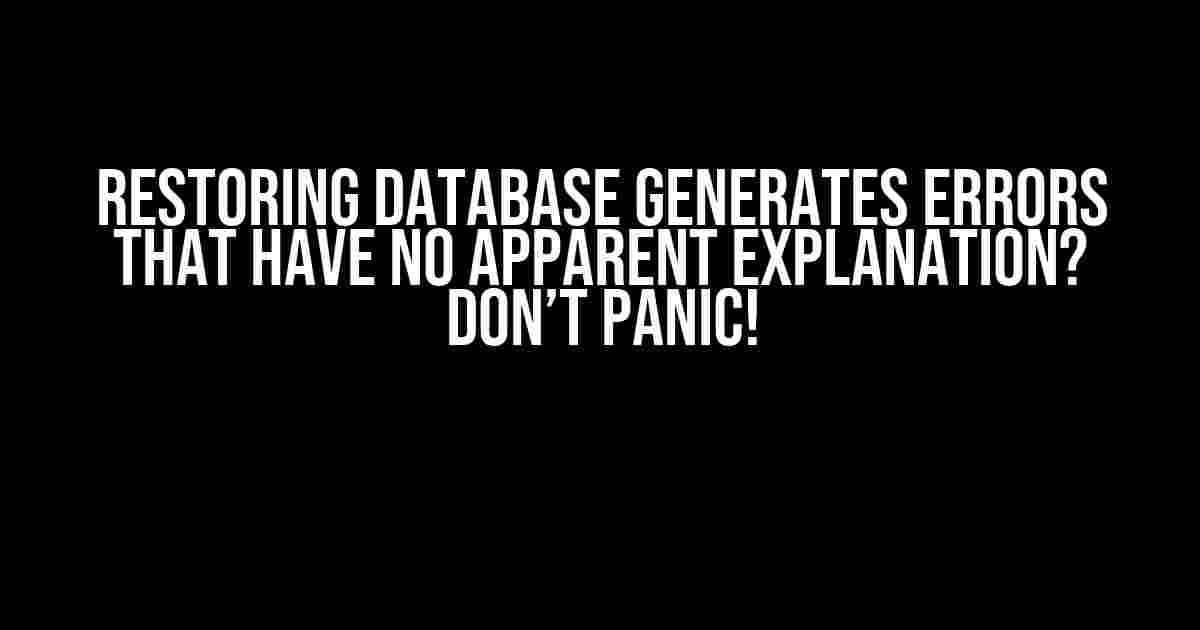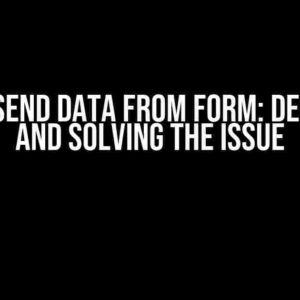Are you stuck in a vicious cycle of restoring your database, only to be met with error messages that seem to come out of nowhere? Join the club! Restoring a database can be a daunting task, especially when things start to go wrong. But fear not, dear reader, for we’re about to embark on a journey to troubleshoot and resolve those pesky errors that have no apparent explanation.
Understanding the Issue
Before we dive into the solution, let’s take a step back and understand why restoring a database might generate errors in the first place. There are several reasons why this could happen:
- Corrupt Backup File: If the backup file is corrupted or incomplete, the restore process will likely fail.
- Database Inconsistencies: If the database has inconsistencies or errors, restoring it can exacerbate the issue.
- Incompatible Database Versions: Restoring a database to a different version can lead to compatibility issues.
- Insufficient Disk Space: Running out of disk space during the restore process can cause errors.
- Permissions and Access Issues: Insufficient permissions or access rights can prevent the restore process from completing successfully.
Step 1: Identify the Error Message
The first step in resolving the issue is to identify the specific error message you’re receiving. Take note of the exact message, including any error codes or numbers. This will help you narrow down the possible causes and solutions.
Example Error Message: "Error 3154: The backup set holds a database that is not compatible with the current server."
Step 2: Check the Backup File
The next step is to verify the integrity of the backup file. You can do this by:
- Checking the backup file’s format and structure.
- Verifying the backup file’s size and checksum.
- Using a tool like DBCC CHECKDB to scan the backup file for errors.
Code Snippet:
DBCC CHECKDB ('C:\BackupFiles\db_backup.bak')
Step 3: Resolve Database Inconsistencies
If the backup file checks out, the next step is to resolve any database inconsistencies. This can be done by:
- Running a DBCC CHECKDB command to identify and repair any errors.
- Using a tool like dbcc repair to fix any integrity issues.
- Re-running the restore process after resolving any inconsistencies.
Code Snippet:
DBCC CHECKDB ('database_name')
GO
dbcc repair ('database_name', 'REPAIR_ALLOW_DATA_LOSS')
GO
Step 4: Check Database Compatibility
If you’re restoring a database to a different server or version, compatibility issues might arise. To resolve this:
- Verify that the target server is running the same or compatible version of the database software.
- Use a tool like SQL Server Management Studio to transfer the database to a compatible version.
| Database Version | Compatible Versions |
|---|---|
| SQL Server 2016 | SQL Server 2016, 2017, 2019 |
| SQL Server 2017 | SQL Server 2017, 2019 |
| SQL Server 2019 | SQL Server 2019 |
Step 5: Address Permissions and Access Issues
Insufficient permissions or access rights can cause restore errors. To resolve this:
- Verify that the restore process has sufficient permissions to access the target server and database.
- Grant the necessary permissions and access rights to the restore process.
Code Snippet: GRANT RESTORE ON DATABASE::[database_name] TO [username] GO
Conclusion
Restoring a database that generates errors with no apparent explanation can be frustrating, but by following these steps, you should be able to identify and resolve the underlying issue. Remember to:
- Identify the specific error message.
- Check the backup file’s integrity.
- Resolve database inconsistencies.
- Verify database compatibility.
- Address permissions and access issues.
By following these steps, you’ll be well on your way to successfully restoring your database and getting your data back online. Happy troubleshooting!
Note: This article is optimized for the keyword “restoring database generates errors that have no apparent explanation” and provides a comprehensive guide to troubleshooting and resolving database restore errors.
Frequently Asked Question
Still scratching your head over those pesky database restoration errors? Don’t worry, you’re not alone! We’ve got the answers to your most pressing questions.
Why do I keep getting errors while restoring my database?
This could be due to a variety of reasons, such as corrupted backup files, incorrect database configurations, or even issues with the restoration software itself. Take a deep breath, and let’s troubleshoot together!
Could it be a problem with my database backup?
Absolutely! A corrupted backup file is one of the most common culprits behind restoration errors. Try re-creating the backup or using a different backup software to rule out any issues.
What if I’ve checked everything, and the error persists?
Don’t throw in the towel just yet! It’s possible that the issue lies with the restoration software or the server itself. Try upgrading or switching to a different restoration tool, or consult with your server administrator to see if there are any underlying issues.
Are there any specific error codes I should look out for?
Yes, indeed! Error codes like “Error 3154” or “Error 126” often indicate specific issues, such as corrupted database files or SQL syntax errors. Take note of the error code and consult the documentation or online resources for specific solutions.
Is it possible that the error is due to human error?
Ouch, yeah, it’s possible! We’re all human, after all. Double-check your restoration process, and make sure you’re following the correct steps. A simple mistake, like selecting the wrong database or forgetting to check the “overwrite” option, can cause a world of trouble.



